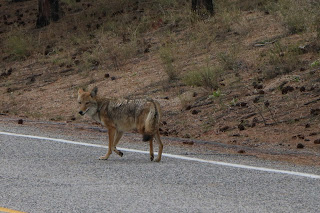We used the propane furnace last night which made for a
comfortable night as temperatures fell to about 40.
We got up with the sunrise and drive to the trailhead for
the Main Loop Trail and Bandelier National Monument, Once there we made blueberry pancakes for
breakfast and then set off into Frijoles Canyon.
The remains along this trail were from Tyuonyl Pueblo, which
consisted of about 400 rooms in this area.
Bandelier is in a valley with a stream that goes to the Rio
Grande River, so while arid, there are quite a few trees. Cottonwood are a pretty yellow now. There are also willows and assorted pine
including a few Pondersa pines (whose bark smells like Vanilla.)
There are a few pictographs. The dwellings continue along the cliff for
quite a ways. Then we cross the stream
and Greg and Gwynne continue on to an area called The Alcove.
This involved climbing many ladders to a cave which was
quite large and impressive. What a climb!
Beth took a leisurely walk back to the parking area,
spotting a few critters like these:
Abert Squirrel, with tall tufts at his ears,
and a tarantula. The ranger later said the tarantulas are mating, so are out "looking for love".It was nice that we arrived early this morning - before the shuttles started arriving, because things were quite busy by the time we finished.
We watched a short film and looked at displays at the
visitors center which was originally a lodge built by the CCC to replace one
that had burned earlier.
This whole area
of New Mexico was a mass of volcanoes at one point.
Lunch of pb&J, grapes and chips before dumping tanks, refilling water and heading
northeast toward Taos. We saw several
mule deer along the road, and later a pair of coyotes. Here's one.
We went through Los Alamos, which is where work on the first
atomic bomb took place. It is still
active in nuclear research and experimentation.
Greg had to show an ID to enter the area and "vouch for" Gwynne and I. Some very nice scenery in the area as we
wound in and out of mountains.
It got progressively colder and cloudier as we
approach Taos. The Taos Pueblo closes around 4:00 so we opt to do that first
thing tomorrow instead of rushing. The town seems to be majorly adobe buildings and homes, with many shops and restaurants.
Beth finds a campsite which is a few miles into the
mountains east of Taos, but as we start to gain in elevation we see several
vehicles coming our way with more than a dusting of snow on them! And then the snow flurries start! Since we aren't really winterized, we turned around and Gwynne gets her
first experience of spending the night at Walmart, at a slightly lower elevation. Cold, but no snow.
First we find a nice restaurant called Casa de Valdez where
Gwynne treats us to a lovely dinner. She
and Greg have some excellent ribs, while Beth has chicken. Yum! Pretty quiet night.
Tuesday, October 10
This morning we find a McDonalds for coffee and a biscuit
before heading to the Taos Pueblo, a UNESCO World Heritage Site.
He gives us a short history of the pueblo including
domination by the Spanish who insisted the Indians become Christians. There was a pueblo revolution in 1680 and the
Spanish were driven out briefly and Catholicism rejected. There was much
violence and death and the old church was destroyed along with many people
including women and children who were sheltering there during the
Mexican/American war.
Eventually
Catholicism and their own spiritualism were joined – for example, he says the
statue of the Virgin Mary is also representative of Mother Earth,
There is no running water or electricity in the Pueblo,
though some do use propane. They carry
water from Willow Creek which runs from the nearby mountains.
There were many
hornos, clay ovens, in the area which
they use for baking as well as firing pottery. Many homes have fireplaces.This Pueblo’s people are known as the Red Willow people and their language is totally oral, passed by word-of-mouth.
Their population is about 2500 and they are a sovereign
government with their own security,
courts, etc. including school till 8th grade. (after which
they must go to the public school).
There were about 30-40 families within the area visitors are allowed
into. Many areas including some with
kivas and homes were off limits. Their mixed feelings about outside visitors may be reflected by this sign:
The main pueblo building
is over 1,000 years old and is 3 stories
high. with the entrance on the 3rd
floor, then ladders down to first story rooms.
(For security). Many of the
inside walls are painted white to brighten the otherwise pretty dark interiors. Many of the names in the cemetery are Spanish
because of intermarriage. There are
several veterans buried there who were either drafted or enlisted.
The area of the pueblo is mostly dirt and dust with some
trees near the water. There were many
dogs wandering around unattended.
After the tour, we were allowed to walk around in the area
open to the public. Many folks had set
up shops in some of the dwellings, selling jewelry, drums, pottery and other
goods that they make. Gwynne bought some
delicious fresh bread and a lovely necklace.
From here we head south through Carson National Forest,
enjoying the scenery and several black and white magpies.
We are looking for a campsite with showers and find Cochiti Lake a bit south of Sante Fe. We enjoy the showers, though they could have been hotter, and have kielbassi for dinner and play some Catch-Phrase, a game that was a gift from Julie way back when she was interning downtown and living with us!






























No comments:
Post a Comment